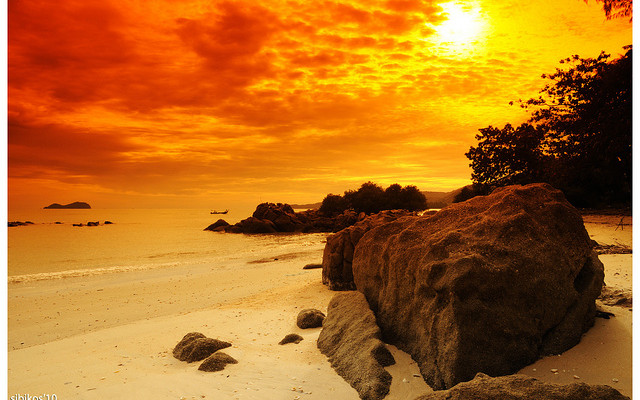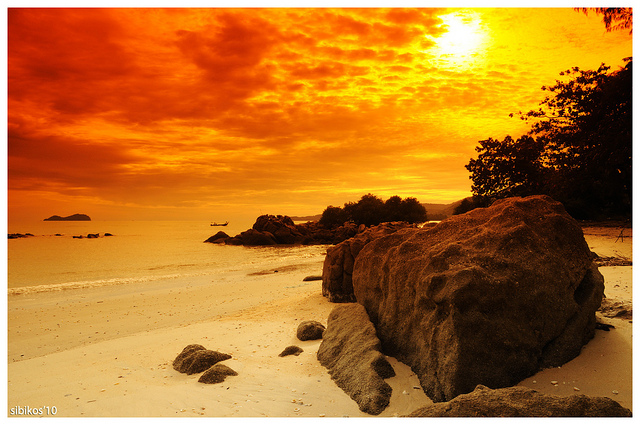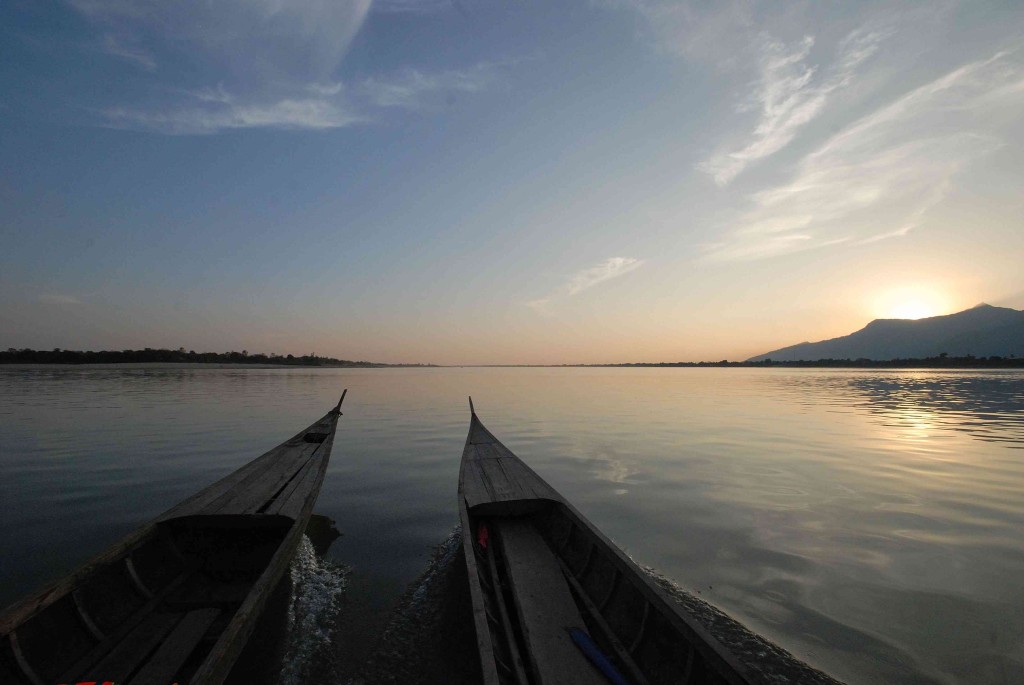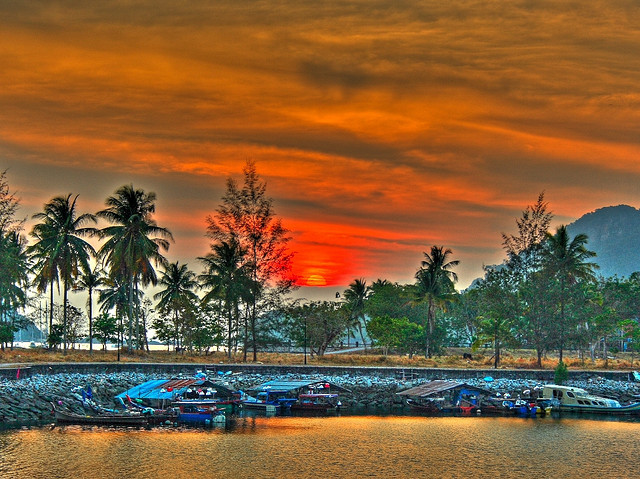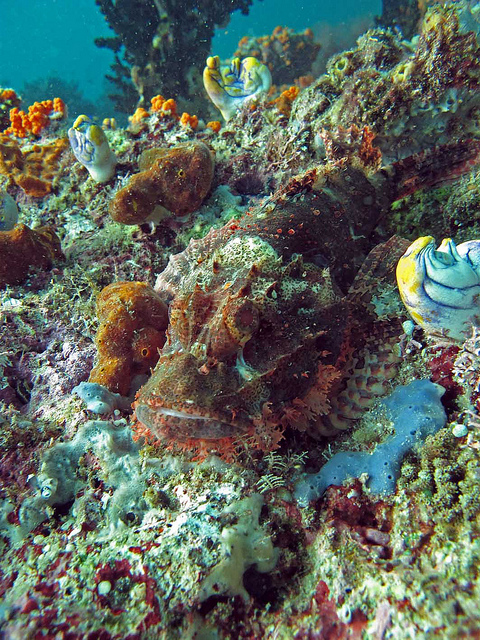By: Simon Hare & Emma Kwee
As a Brit, a love of island life is in my DNA and like many of my fellow countrymen I was brought up on island holidays: The Isle of Wight, Jersey, and for the more adventurous, Mallorca, Malta or even Cyprus. As if that wasn’t enough our literature is peppered with island-based fun and fantasy: Swallows and Amazons, Treasure Island, Robinson Crusoe and of course Kirrin Island, scene of many an adventure for Enid Blyton’s Famous Five.
It’s hardly surprising, then, that the draw of Southeast Asia’s idyllic islands has proven too much to resist as an adult. There are thousands to choose from, but here’s the lowdown on just a few of our favourite tropical islands and some ideas on where to stay when you get there…
Penang: Malaysia in miniature
If Malaysia is a symbol of a (mostly) harmonious multi-cultural society then Penang, and UNESCO world heritage listed Georgetown are the perfect microcosm of the nation as a whole, and therefore a really quick and easy way to see many of the facets of this amazing country all in one small area.
The island boasts long sandy beaches lined with luxury resorts and hotels, and mountains clad in unspoilt rainforest where you can marvel at beautiful specimens at The Penang Butterfly Farm and sample fruits whose names you have never even heard of at The Penang Tropical Fruit Farm.
Georgetown, the island capital is home to thriving Malay, Chinese, Muslim, Indian and Christian communities and some beautiful British colonial buildings around the 18th Century Fort Cornwallis complex. In some parts of town you can literally sense the cultural change as you cross the street from one quarter to another, the smells of streetfood and temple offerings drifting in the air marking your arrival in a new and different world.
Trumping the myriad places of worship in Georgetown is the stunning hillside Kek Lok Si Temple just outside the city, with wonderful views of the island. And nearby is the temple of Nattukottar Chettai, the focus of the annual Hindu Festival of Thaipusam when hundreds of devotees wend their way up the slopes of Waterfall Hill bearing hooks and chains in the most astonishing examples of penitent body-piercing you are likely to come across. Time it well and you can take in Thaipusam, Chinese New Year, and the sweetheart festival of Chap Goh Meh all in one trip.
Options for overnight stays are many, from backpacker joints to five star luxury. The Eastern & Oriental Hotel overlooking the Andaman Sea at the north end of Georgetown is a celebration of colonial charm. High ceilings, a vast ballroom, polished tile floors, the old-fashioned politesse of uniformed doormen and bell boys, plus a past guest list that includes Rudyard Kipling, Noel Coward and Hermann Hesse conspire to transport you to a gentler era. Opened in 1885 by the Sarkies Brothers, who were also responsible for Singapore’s Raffles and The Strand in Yangon, the “E & O” may be slightly faded these days, but that just adds to its undeniable air of romance. Doubles from around $195/£125.
Of equal but quite different historic significance is a relative rookie on the Georgetown accommodation scene. The Straits Collection is a series of 19th century shop houses, recently rescued, renovated and revamped to offer an authentic Penang bolt hole in the shape of rooms and apartments right in the heart of the heritage area of town. Meticulous attention to detail and luxurious touches have elevated these previously dilapidated homes to the pages of many a glossy interiors magazine. Two-storey residences from $140/£90 a night.
Nearest airport: Penang International Airport.
Don Daeng, Laos: A million miles from Four Thousand Islands
If you’ve had it with full moon parties, cheap vodka Red Bull buckets and a ready supply of hash, but still crave that lazy Mekong island vibe that only laid back Laos can offer, head north along the river from The Four Thousand Islands until you reach their grown up neighbour, Don Daeng. Facing the town of Champasak with its mystical pre-Angkorian temples ruins of Wat Phu, Don Daeng is the perfect antidote to the excesses of its southerly neighbours. A rickety “ferry” consisting of wooden planks lashed to two longtail boats transports you from the “mainland” to the quiet, traffic-free island.
Relaxation is the only option when there is little to do apart from walk or cycle amongst the rice fields and tiny villages, dodging water buffalo and collecting hundreds of “sabaidees” from friendly local children on the way or chilling out on the palm shaded poolside deck of the island’s only hotel, La Folie Lodge. La Folie’s wooden bungalows are traditional in style without being overly rustic and are scattered around lush gardens bordering the river in wet season and a vast sandy river beach during the cooler dry season from December to April. The on-site bar and restaurant, and free bicycles make it eminently possible to remain blissfully cocooned in total tranquillity for days on end. Bungalows from $50/£32 a night, low season.
Nearest Airport: Pakse International Airport.
Phu Quoc, Vietnam: Go now, before it’s too late
Phuc Quoc is Vietnam’s answer to the Phuket or Koh Samui that intrepid travellers fell in love with twenty years ago. Construction of a new airport and scary visitor targets mean that you’d better get there fast to enjoy all that this teardrop shaped slice of paradise offers.
Home to an astonishing array of endangered plant and animal species, Phu Quoc boast pristine rainforest, world class dive sites, and as yet mostly unspoilt beaches. Traditional fishing villages, a sobering museum housed in the island’s infamous former POW camp, and a fascinating temple to one of the world’s more idiosyncratic religions, Cau Dai, provide handy diversions for those who tire easily of beachside relaxation.
Backpacker accommodation and all the standard gap year attractions can be found at the north end of Long Beach, a narrow 20km stretch of sand that is just beginning to show signs of being spoilt by over-zealous development. Sitting proudly and serenely amongst the hustle and bustle of Long Beach however is La Veranda, a reassuringly old fashioned and upmarket colonial style resort with cool, spacious rooms, villas and suites, pool, bar, restaurant and spa. Rooms from $189/£121 a night in low season.
Resorts in the north of the island enjoy more tranquil locations, and prettier beaches, but come at a price. The Chen Sea Resort and Spa overlooks its own private beach, and offers indoor and outdoor dining, the full range of spa and beauty treatments, yoga classes, island tours, water sports, and speedboat taxis from the hotel jetty right into the centre of the island’s diminutive capital, Doung Dong. The spacious ultra-chic standard bungalows are a cool fusion of tropical and industrial designs with private terraces and bathrooms with luxurious outdoor showers. Reconstructed Hoi An timber houses and private pool villas are also available. Prices from $240/£155 a night.
Nearest airport: Phu Quoc airport, domestic flights only.
Langkawi, Malaysia: Lush and laid-back, land of legends
Understated, undeveloped and unspoilt, this Malaysian gem punches way above its weight in the perfect island stakes. Setting foot outside your luxury hotel or beachfront cabana is like stepping into one enormous zoological park. Giant hornbills, long tailed macaques and shy dusky leaf monkeys fill the forest canopy and at night flying foxes can be seen gliding from tree to tree. You can even view the rainforest from above by taking the cable car to the summit of Langkawi’s highest mountain, Gunung Raya, and walking along the stunning aerial walkway.
At sea level gargantuan monitor lizards wade through crystal clear waters on sugar white beaches as brahminy kites and white bellied sea eagles scour the water for prey. Neighbouring islands also offer myriad touring opportunities – from snorkelling and diving at the Pulau Payar marine park to swimming in the enchanted lake on The Island of The Pregnant Maiden.
Langkawi’s celebrated Datai Hotel, surrounded by rainforest on a remote horseshoe shaped bay regularly makes it onto the world’s best hotels lists. Its location is breathtaking, facilities and service out of this world and guests staying here will want for nothing whether staying in a secluded standard room or a truly luxurious beach villa with its own private pool. Rooms from $545/£350 a night.
If you fancy somewhere a little different, The Bon Ton Resort could be for you. Eight timber Malay village houses have been transported to a surprisingly quiet spot near the airport, overlooking a flower and bird-filled lagoon. Here they have been painstakingly restored and their interiors brought up to the same glossy magazine standards as sister property The Straits Collection in Penang (see above). Air conditioning, refrigerators, and outdoor wooden bath tubs along with traditional architecture make for a unique and historical place to lay your head. Houses sleep from 2-5 people and prices start at $205/£130.
Next door to The Bon Ton is The Temple Tree another masterpiece from the same inspirational owner, Narelle McMurtrie. A leafy estate of much grander restored timber houses provides the same high standard of rooms and suites as its neighbour, and comes complete with two pools and a rather refined colonial club room for those all-important cocktails before dinner at The Bon Ton’s superb restaurant. One Suite has a mini gym and one even has its own private “cinema”. Rooms from $185/£118.
Bon Ton and The Temple Tree are just minutes from two of Langkawi’s best beaches –Pantai Cenang and Pantai Tengah, where fine white sand and a good selection of bars and restaurants combine to offer the perfect setting for a romantic meal or sunset drink.
Nearest airport: Langkawi international Airport.
Gili Asahan, Lombok, Indonesia: A secluded piece of paradise
Gili Asahan is a small island located in the Bay of Sekotong in South West Lombok. Gili Asahan is serene and quiet, especially compared to the crowd-pleasers Gili Trawangan, Gili Menoh en Gili Air, in the north west of Lombok. It is an island without cars, motorbikes or even horse-drawn carriages.
The small scale Pearl Beach Resort is the perfect place to unwind. They offer comfortable beach bungalows and simple bamboo cottages, both very reasonably priced. The cozy resort works together with Divezone, an excellent dive center. Diving around the Bay of Sekotong is magnificent, beautiful corals, giant sea turtles and – for the daredevils – hammerhead sharks await you at Belongas Bay.
Non divers can hike around the island in about 1.5 hour, visit the village, or explore the surroundings with a kayak. The resort also organizes trips to Lombok (not that you’ll ever want to leave once you set foot on Gili Asahan).
Raja Ampat, Indonesia: Stunning Above and Under Water
This remote island group is located off the northwest tip of the island of New Guinea. Raja Ampat is comprised of over 1500 islands surrounding the four main islands of Misool, Salawati, Batanta and Waigeo. The stunning beauty both under and above water make this archipelago unique. In Cenderawasih Bay, the largest marine national park in Indonesia, you can dive with over 1,070 fish species, including whales! Various marine surveys suggest that the marine life diversity in the Raja Ampat area is the highest recorded on Earth.
As Raja Ampat is not part of any major tourist route yet, getting there can be a challenge. Your best bet is to fly to Sorong from Jakarta (6 hours) or Singapore (7,5 hours). There are daily ferries available between Sorong and Waisai, capital of the Raja Ampat district on the island of Waigeo. Ferries leave Sorong at 13.00 hrs and the journey takes between 1.5 to 2 hours. The return ferry from Waisai to Sorong leaves around 11.0 am. There are also speedboats for rent at Sorong. Alternatively, you can book a diver trip in Sorong.
Be aware that a fee of 500,000 Indonesian Rupiah (55 USD) (250,000 Rp for Indonesian citizens) is levied on all international visitors to the Raja Ampat National Park, with the proceeds earmarked for community development, conservation and patrol programs. You’ll find more info on Raja Ampat and where to stay on the website of Raja Ampat Homestays.
Whichever island you choose, be sure to check for special deals on all the usual hotel booking sites!

